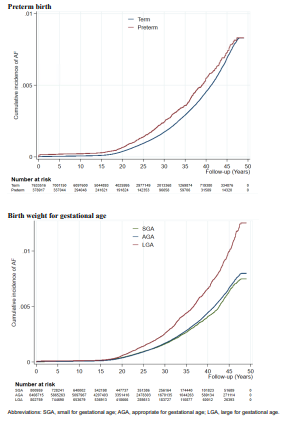2023-04-24 カロリンスカ研究所(KI)
JAMA Pediatricsに掲載されたこの研究は、早産または胎児の発育過程が大きかったことが、後に心房細動のリスクを増加させることが示されています。出生時に発育遅延があった場合は、18歳までの心房細動のリスク増加にしか関連していませんでした。
研究者たちは、今後、早産や胎児の成長と老年までの心房細動のリスクの関連性を調べる必要があると述べています。
<関連情報>
- https://news.ki.se/new-insights-on-the-risk-for-atrial-fibrillation-in-children-and-young-adults
- https://jamanetwork.com/journals/jamapediatrics/fullarticle/2804202
早産、低体重児出産、高体重児出産、中年期までの心房細動のリスク Preterm Birth, Small for Gestational Age, and Large for Gestational Age and the Risk of Atrial Fibrillation Up to Middle Age
Fen Yang,Imre Janszky,Mika Gissler,Sven Cnattingius,Nathalie Roos,Maohua Miao,Wei Yuan, Jiong Li, Krisztina D. László
JAMA Pediatrics Published:April 24, 2023
DOI:10.1001/jamapediatrics.2023.0083

Key Points
Question Are preterm birth, small for gestational age, and large for gestational age associated with increased risks of atrial fibrillation (AF) up to age 49 years?
Findings In this multinational cohort study with 8 million participants, preterm birth and large for gestational age were associated with increased risks of AF in childhood and up to age 49 years in adulthood, while an association between small for gestational age and an increased risk of AF was observed only in childhood. Similar findings were observed in sibling analyses.
Meaning Preterm birth, excessive fetal growth, and reduced fetal growth may increase the risk of AF up to age 49 years.
Abstract
Importance Adverse birth outcomes, including preterm birth, small for gestational age (SGA), and large for gestational age (LGA) are associated with increased risks of hypertension, ischemic heart disease, stroke, and heart failure, but knowledge regarding their associations with atrial fibrillation (AF) is limited and inconsistent.
Objective To investigate whether preterm birth, SGA, or LGA are associated with increased risks of AF later in life.
Design, Setting, and Participants This multinational cohort study included Danish, Swedish, and Finnish national health registries. Live singleton births in Denmark from 1978 through 2016, in Sweden from 1973 through 2014, and in Finland from 1987 through 2014, who were followed up until December 31, 2016, in Denmark, December 31, 2021, in Sweden, and December 31, 2014, in Finland were included. Data analyses were performed between January 2021 and August 2022.
Exposures Preterm birth (less than 37 gestational weeks), SGA (less than 10th percentile birth weight for gestational age), and LGA (more than 90th percentile birth weight for gestational age) identified from medical birth registers.
Main Outcomes and Measures Diagnosis of AF obtained from nationwide inpatient and outpatient registers. The study team ran multivariable Cox proportional hazard models and flexible parametric survival models to estimate hazard ratios (HRs) and 95% CIs for AF according to preterm birth, SGA, and LGA. Sibling analyses were conducted to control for unmeasured familial factors.
Results The cohort included 8 012 433 study participants (maximum age, 49 years; median age, 21 years; male, 51.3%). In 174.4 million person-years of follow-up, 11 464 participants had a diagnosis of AF (0.14%; median age, 29.3 years). Preterm birth and LGA were associated with increased AF risk in both the full population cohort and in the sibling analyses; the multivariate HRs from the cohort analyses were 1.30 (95% CI, 1.18-1.42) and 1.55 (95% CI, 1.46-1.63), respectively. Preterm birth was more strongly associated with AF in childhood than in adulthood. Children born SGA had an increased risk of AF in the first 18 years of life but not afterwards.
Conclusions and Relevance Preterm births and LGA births were associated with increased risks of AF up to middle age independently of familial confounding factors. Individuals born SGA had an increased AF risk only during childhood.


